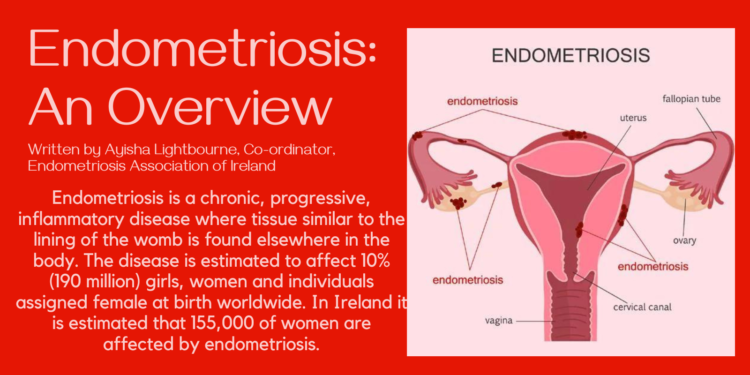Endometriosis is a chronic, progressive, inflammatory disease where tissue similar to the lining of the womb is found elsewhere in the body. The disease is estimated to affect 10% (190 million) girls, women and individuals assigned female at birth worldwide. In Ireland it is estimated that 155,000 of women are affected by endometriosis.

Written by Ayisha Lightbourne, Co-ordinator, Endometriosis Association of Ireland
The condition creates an inflammatory reaction, which can result in the development of scar tissue and lesions throughout the body. There are numerous types of lesions that exist and vary in severity depending on the stage of the disease.
What are the symptoms?
Endometriosis symptoms may develop before the first menstrual cycle and on past menopause, which can significantly impact quality of life.
This disease can be associated with a range of different symptoms including painful periods, menstruation pain, pelvic pain, discomfort during and after sex, unexplained fatigue, bloating, nausea, infertility and more. Pain can be cyclical or daily and mild to severe. This is not a complete list of symptoms, as endometriosis affects everyone differently and causes a variety of ailments, not all of which are physical, it can also be completely asymptomatic, making it difficult to diagnose and treat.
Diagnosing Endometriosis
A definitive diagnosis is only possible with a laparoscopy. Tissue suspected of containing endometriosis is extracted during the laparoscopy and sent to the pathologist to be examined under a microscope to confirm the diagnosis. The American Society of Reproductive Medicine (ASRM) developed a staging system for the disease and is classified according to prevalence:
Stages 1 and 2: minimal to mild disease – superficial endometriosis which is found primarily in the pelvis.
Stages 3 and 4: moderate to severe disease – deep penetrating endometriosis can be found on the bladder, bowel and on other organs outside of the pelvis.
However, prevalence does not correspond with discomfort; someone in stage 1 can have chronic daily pain, whilst someone in stage 4 may not have any pain at all. This complicates diagnosis because it is frequently overlooked or confused with other illnesses such as IBS and ovarian cysts.
Treating Endometriosis
There is currently no cure for endometriosis. The different treatment options available for endometriosis aim to decrease the severity of symptoms and improve the quality of life for individuals living with the condition and are also dependent on a person’s individual situation.
Hormonal medication, usually in the form of contraceptives, is one of the first types of treatments prescribed to those affected by the disease to help reduce the severity of symptoms. Hormone therapy may include: the pill, IUDs, implants, injections, patches or vaginal rings.
Analgesics like paracetamol and non-steroidal anti-inflammatory drugs (NSAIDs) can help reduce pain felt by sufferers. NSAIDs are a preferred type of pain relief due to inflammation caused by endometriosis. In some cases, standard pain killers may not be proficient in helping to relieve symptoms and co-codamol/ co-dydramol or opioids may be prescribed.
In many cases, surgery is required for the treatment of endometriosis. Surgical interventions look to remove endometriosis lesions, divide adhesions, and restore nerve pathways. Excision and ablation surgery are the techniques used to treat endometriosis. Excision is the physical removal of the lesions and surrounding tissue while ablation vaporises and destroys the tissue. The recurrence rate with ablation is much higher therefore excision surgery is considered the gold standard. It is a common misunderstanding that a hysterectomy will “cure” endometriosis. This is not true because the lesions do not originate from the uterus. If endometriosis is not treated and removed during a hysterectomy, symptoms may persist after the surgery. Those on HRT (even those without a womb or using an IUD) can benefit by including body identical progesterone into their regimen. A holistic approach is required for managing symptoms and should include complementary and alternative therapies to assist with pain management.
Endometriosis can be a debilitating condition. Much more rigorous research is needed to understand the disease better and to learn how to treat the condition more effectively. To find out more visit https://www.endometriosis. ie/ or email info@endometriosis. ie and you can also sign up to become a member of the EAI for free via our website.









